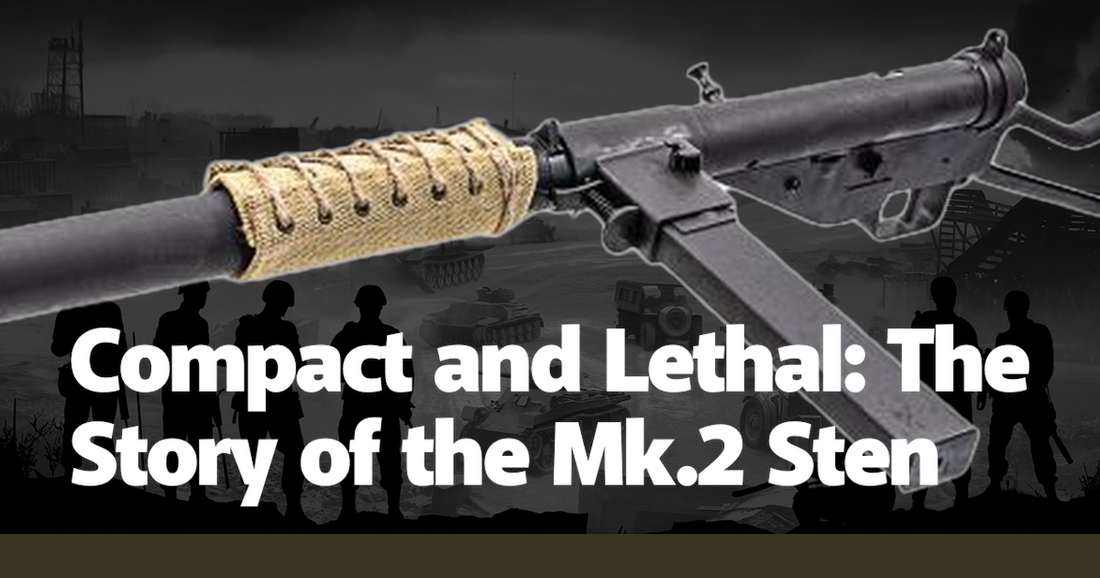The Mk.2 Sten gun, a weapon that became synonymous with the British resistance during World War II, is a tale of ingenuity born out of necessity. As Nazi Germany's blitzkrieg swept across Europe, the British Army found itself in dire need of a cost-effective, easily producible submachine gun. The Sten, conceived in the early 1940s, was the answer to this urgent call. Named after its designers, Major Reginald V. Shepherd and Harold Turpin, and the Enfield factory where it was produced, the Sten was a marvel of wartime engineering. Its design was deceptively simple, featuring a rudimentary blowback operation, a side-mounted magazine, and a skeletal metal frame. But beneath its crude exterior lay a weapon that would become a cornerstone of the Allied war effort.
The Sten's compact design was one of its most defining features. Measuring just over 30 inches in length and weighing a mere 7 pounds, it was a weapon that could be easily concealed and transported. This made it an ideal choice for paratroopers, resistance fighters, and commandos who needed a reliable firearm that wouldn't encumber them. The Sten could be broken down into its component parts and reassembled with minimal tools, a feature that was particularly useful for covert operations. Its 9mm cartridge was standard across many Allied and Axis forces, ensuring that ammunition was readily available even in enemy territory. This adaptability was a key factor in the Sten's widespread use and enduring legacy.
The Sten's lethality was another critical aspect of its design. With a rate of fire of around 500 rounds per minute, it was capable of delivering a devastating volume of fire in close-quarters combat. Its simple blowback mechanism, while prone to jamming if not properly maintained, allowed for rapid and sustained fire. This made the Sten particularly effective in urban warfare, where its compact size and high rate of fire could be used to great advantage. The weapon's effectiveness was demonstrated time and again in the hands of British commandos and resistance fighters, who used it to great effect in sabotage missions, assassinations, and guerrilla warfare.
One of the most famous uses of the Sten gun was during the assassination of SS-Obergruppenführer Reinhard Heydrich, one of the principal architects of the Holocaust. In 1942, Czechoslovakian resistance fighters Jan Kubiš and Jozef Gabčík, trained by the British Special Operations Executive, ambushed Heydrich's car in Prague. Gabčík's Sten gun jammed at the critical moment, forcing Kubiš to throw a grenade that mortally wounded Heydrich. Despite the malfunction, the operation highlighted the Sten's role in resistance efforts across occupied Europe. It was a weapon that, despite its flaws, could be a decisive tool in the hands of those fighting against tyranny.
The Sten's production was a testament to British industrial ingenuity. At a time when resources were scarce, the Sten was designed to be manufactured quickly and cheaply. Its construction required minimal machining and could be assembled by semi-skilled labor. This allowed for mass production at a rate that far outpaced more complex firearms. By the end of the war, over four million Sten guns had been produced. Factories across the British Empire, from Canada to India, contributed to this monumental effort. The Sten's simplicity and ease of production made it an ideal weapon for a nation under siege, and its widespread availability ensured that it would be a ubiquitous presence on the battlefields of World War II.
The Sten's impact extended beyond the British military. It became a symbol of resistance for occupied nations across Europe. The French Maquis, the Dutch underground, and the Yugoslav Partisans all made extensive use of the Sten. Its ease of use and maintenance meant that it could be operated by individuals with minimal training, making it an ideal weapon for irregular forces. The Sten's role in these resistance movements cannot be overstated. It provided a means for ordinary citizens to fight back against their oppressors, leveling the playing field in a conflict where the balance of power was heavily skewed in favor of the Axis forces.
Despite its many advantages, the Sten was not without its critics. Its crude construction and propensity for jamming earned it a reputation for unreliability. Soldiers often referred to it derisively as the "Stench Gun" due to its tendency to malfunction. However, those who mastered its quirks found it to be a reliable and effective weapon. The Sten's simplicity was both its greatest strength and its greatest weakness. It was a weapon that required careful handling and regular maintenance, but in the hands of a skilled operator, it could be a formidable tool of war. Its legacy is a testament to the ingenuity and resourcefulness of those who designed and used it.
In the post-war years, the Sten continued to see service in conflicts around the world. It was used by various armies and paramilitary groups in the tumultuous years following World War II. Its influence can be seen in the design of later submachine guns, such as the Sterling and the Uzi. The Sten's story is one of adaptation and resilience. It was a weapon born out of necessity, designed to meet the urgent needs of a nation at war. Its impact on the course of World War II and its legacy in the years that followed are a testament to its enduring significance. The Mk.2 Sten remains a symbol of the ingenuity and determination that defined the Allied war effort, a compact and lethal reminder of a time when the fate of the world hung in the balance.

